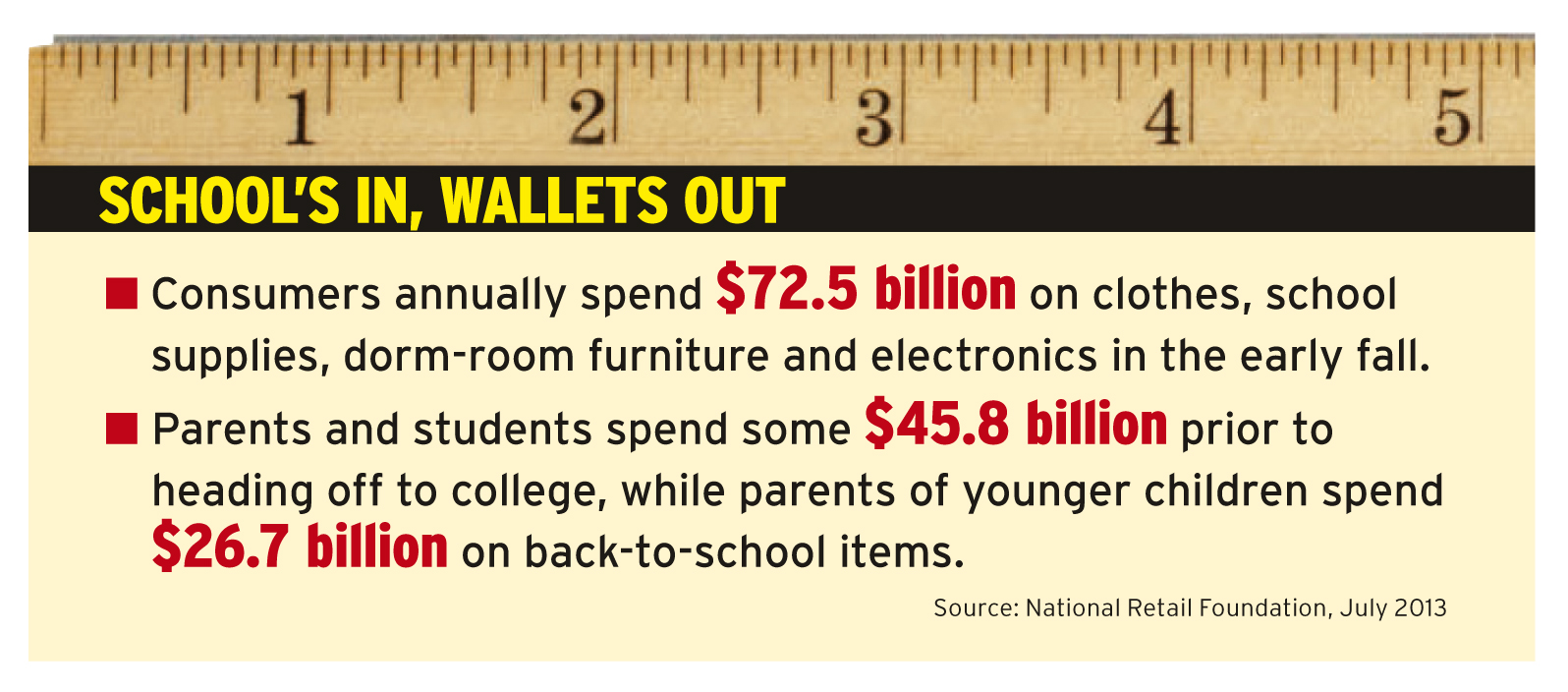Back-to-School SpendA Good Value Lesson

palbiniak@gmail.com | @PaigeA
Consumers traditionally rev up to part with cash in August and early September when kids head back to school and go off to college, making this the second-largest retail spend period of the year. That’s why syndicators should really reconsider whether lying low in the doldrums of summer is good business.
In July, the National Retail Foundation noted that consumers spend $72.5 billion on clothes, school supplies, dorm-room furniture and consumer electronics in early fall. That breaks down to parents and students spending $45.8 billion prior to heading off to college, while parents of younger children spend $26.7 billion to send their kids back to school. Another wrinkle extending the 2013 shopping season in key markets is New York-area public schools returning later than usual (Sept. 9) due to the Rosh Hashanah holiday, and the Los Angeles Unified School District moving much earlier, to Aug. 13.
That’s not much compared to the towering $580 billion consumers spend around the holidays, but it’s more than any other time of the year, including Mother’s Day ($20.7 billion) and Valentine’s Day ($18.6 billion).
Most back-to-school shopping takes place in July and August, two of the slowest months of the year for TV, which remains marketers’ preferred showcase. Other ad categories that get a lot of play in summer are automotive—especially July, which tends to be a hot month for buying cars— and movies, with studios rolling out blockbusters.
Syndication offers marketers an advantage in those slow months, says Mitch Burg, Syndicated Network Television Association president. “[Syndication ratings] don’t vary more than 10% across the year,” he says. “In the summer, syndication’s ratings hold up better than any other part of national TV. Meanwhile, ratings for broadcast network primetime fall as much as 40% from their end-of-season average.”
Plenty of Options
Among women over 18 who have kids, Warner Bros.’ The Big Bang Theory in syndication was TV’s top-rated show, averaging a 2.7 C3 rating from July 1-July 14, according to Nielsen. Bang was followed by such syndie staples as CBS Television Distribution’s JudgeJudy (2.0), Debmar-Mercury’s Family Feud (2.0), NBCUniversal’s Law & Order: SVU (1.9), Litton’s Weekend Adventure weekend programming block (1.8), Twentieth’s Family Guy (1.7) and Warner Bros.’ Two and a Half Men and NBCU’s Maury (both 1.5). By comparison, network primetime programming averaged a 1.2 and cable primetime averaged a 0.2 in the same female demo.
Sitcoms are strong performers among young people age 18-24, many of whom are shopping to return to college. In this demo, Family Guy reigned supreme at a 2.9, followed by Big Bang at a 2.2, How I Met Your Mother and King of the Hill each at a 1.7 and Two and a Half Men at a 1.3. By comparison, network primetime averaged a 0.5 among this age group, while cable averaged just a 0.1, according to Nielsen.
“When you have seven of the top 10 shows on a weekly basis, that’s a pretty significant thing,” says Burg. “That’s why a lot of [marketers] have moved money into syndication in the summer. Many marketers spend more money with us in the summer than in other quarters.”
Broadcasting & Cable Newsletter
The smarter way to stay on top of broadcasting and cable industry. Sign up below
Contributing editor Paige Albiniak has been covering the business of television for more than 25 years. She is a longtime contributor to Next TV, Broadcasting + Cable and Multichannel News. She concurrently serves as editorial director for The Global Entertainment Marketing Academy of Arts & Sciences (G.E.M.A.). She has written for such publications as TVNewsCheck, The New York Post, Variety, CBS Watch and more. Albiniak was B+C’s Los Angeles bureau chief from September 2002 to 2004, and an associate editor covering Congress and lobbying for the magazine in Washington, D.C., from January 1997 - September 2002.










